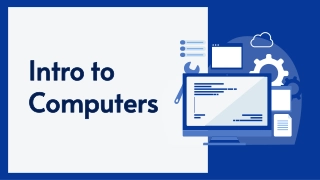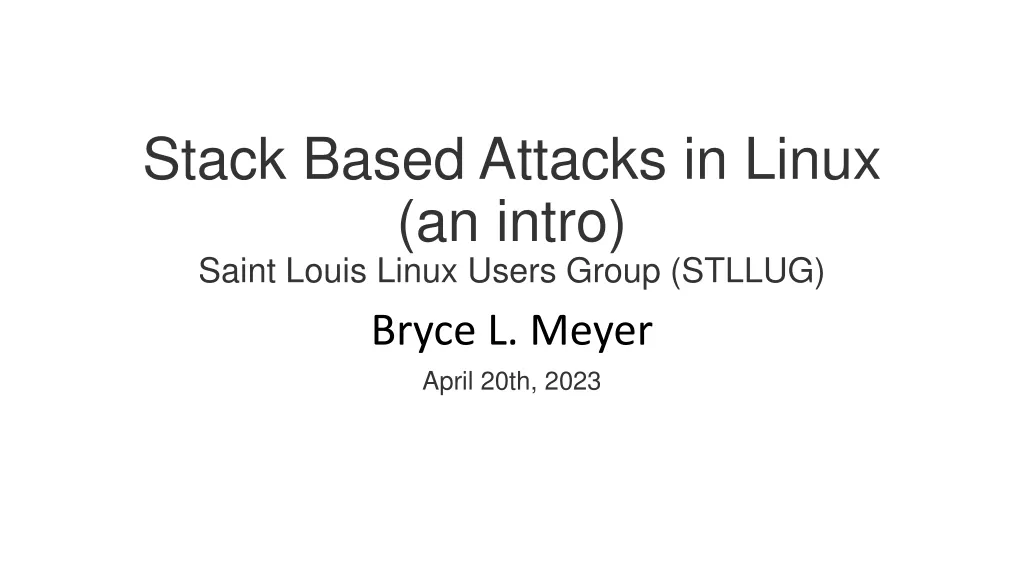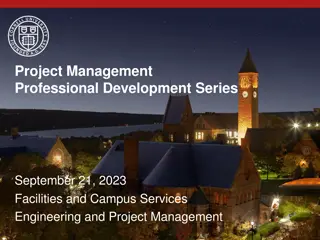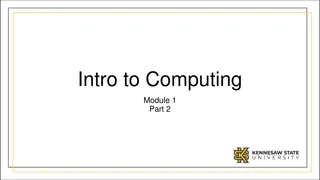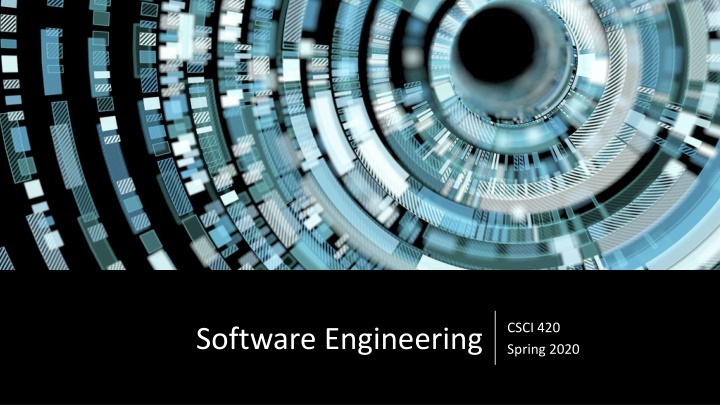
Learn Software Engineering through Real-world Projects
Dive into software engineering by working on group projects, acquiring hands-on experience in building large-scale systems, gathering requirements, and designing software solutions. No compulsory textbooks, just practical learning guided by suggested readings and real-world problem-solving.
Download Presentation

Please find below an Image/Link to download the presentation.
The content on the website is provided AS IS for your information and personal use only. It may not be sold, licensed, or shared on other websites without obtaining consent from the author. If you encounter any issues during the download, it is possible that the publisher has removed the file from their server.
You are allowed to download the files provided on this website for personal or commercial use, subject to the condition that they are used lawfully. All files are the property of their respective owners.
The content on the website is provided AS IS for your information and personal use only. It may not be sold, licensed, or shared on other websites without obtaining consent from the author.
E N D
Presentation Transcript
CSCI 420 Spring 2020 Software Engineering
Course Material There is no compulsory textbook for the course There will be a list of suggested readings from web resources and research papers on the course website Debugging Teams Interesting books to read: Steve McConnell: "Code Complete: A Practical Handbook of Software Construction", ISBN-10: 0735619670 Roger Pressman: "Software Engineering: A Practitioner's Approach", ISBN-10: 0073375977 Ian Sommerville: "Software Engineering", ISBN-10: 0137035152
The Project The only way to learn software engineering is by writing a large piece of code in a group A BIG project solving a real-world problem Can be (almost) anything Done in teams of 4-6 students You do everything Gather requirements, design, code, and test in several assignments This class should be very close to a startup experience
Project Timeline Team assignments Projects will be reviewed and analyzed by each other! Requirements and specification Project design & plan Design review Done by instructor, sometimes other teams Revised design & plan Testing Tests performed by YOU (and me) NOT an afterthought!
The Ideas Behind the Project Structure We will simulate the real world In the real world, you often spend a lot of time maintaining/extending other people s code This is where specifications, interfaces, documentation, etc pays off Shows the importance of institutional knowledge
What this course is (not) about? Do not expect to learn a new language Do not expect to learn programming tricks But you ll learn techniques for programming in the large Do not expect to learn management skills from the lectures Some things you learn by doing, not through lectures!
What this course is about? Learn how to build a large software system in a team Learn how to collect requirements Learn how to write specification Learn how to design Reliability is central to software engineering: This constitutes significant part of the course Version Control Testing Debugging Dynamic Analysis
What is Software Engineering? As defined in IEEE Standard 610.12: The application of a systematic, disciplined, quantifiable approach to the development, operation, and maintenance of software; that is, the application of engineering to software. Your opinion? This definition is descriptive, not prescriptive It does not say how to do anything It just say what qualities S.E. should have As a result many people understand SE differently
Software Engineering Myths: Management We have books with rules. Isn t that everything my people need? Which book do you think is perfect for you? If we fall behind, we add more programmers Adding people to a late software project, makes it later Fred Brooks We can outsource it If you do not know how to manage and control it internally, you will struggle to do this with outsiders
Software Engineering Myths: Customer We can refine the requirements later A recipe for disaster. The good thing about software is that we can change it later easily As time passes, cost of changes grows rapidly
Software Engineering Myths: Practitioner Let s write the code, so we ll be done faster The sooner you begin writing code, the longer it ll take to finish 60-80% of effort is expended after first delivery Until I finish it, I cannot assess its quality Software and design reviews are more effective than testing (find 5 times more bugs) There is no time for software engineering But is there time to redo the software?
Our goals for software engineering We want to build a system How will we know the system works? How do we develop system efficiently? Minimize time Minimize dollars Minimize How do we make software reliable?
How Do We Know the System Works? Buggy software is a huge problem But you likely already know that Defects in software are commonplace Much more common than in other engineering disciplines Examples (see Software Crisis reading) This is not inevitable---we can do better!
Software BUGs SPACE disaster Maiden flight of the Ariane 5 rocket on the 4th of June 1996 The reason for the explosion was a software error (Attempt to cram a 64-floating point number to a 16-bit integer failed) Financial loss: $500,000,000 (including indirect costs: $2,000,000,000)
Financial Impact of Software Errors Recent research at Cambridge University (2013, link) showed that the global cost of software bugs is around 312 billion of dollars annually Goal: to increase software reliability
How to identify software bugs? How do we know behavior is a bug? Because we have some separate specification of what the program must do Separate from the code Thus, knowing whether the code works requires us first to define what works means A specification
Teams and Specifications Do we really need to write specifications? A typical software team will in general do the following: Discuss what to do Divide up the work Implement incompatible components Be surprised when it doesn t all just work together
Cartoon 19
Cartoon 20
Cartoon 21
Cartoon 22
Cartoon 23
Cartoon 24
Cartoon 25
Cartoon 26
Cartoon 27
Cartoon 28
Specification A specification allows us to: Check whether software works Build software in teams at all Actually checking that software works is hard Code reviews Static analysis tools Testing and more testing We will examine this problem closely
How Do We Code Efficiently? Assume we want to minimize time Usually the case Time-to-market exerts great pressure in software How can we code faster? Obvious answer: Hire more programmers!
Parallel Development How many programmers can we keep busy? As many as there are independent tasks People can work on different modules Thus we get parallelism And save time What are the pitfalls?
Pitfalls of Parallel Development The problems are the same as in parallel computing More people = more communication Which is hard Individual tasks must not be too fine-grain Increases communication overhead further
Interfaces The chunks of work must be independent But work together in the final system We need interfaces between the components To isolate them from one another To ensure that the final system works The interfaces must not change (much)!
Defining Interfaces Interfaces are just specifications! But of a special kind Interfaces are the boundaries between components And people Specifying interfaces is most important Interfaces should not change a lot Effort must be spent ensuring everyone understands the interfaces Both things require preplanning and time But often we can stop at specifying interfaces Let individual programmers handle the internals themselves
Efficient software development Efficient development requires Decomposing system into pieces Good interfaces between pieces The pieces should be large Don t try to break up into too many pieces Interfaces are specifications of boundaries Must be well thought-out and well communicated
How to obtain Software Reliability? Testing, testing, testing, Many software errors are detected this way Does not provide any correctness guarantee Murphy s Law Verification Provides a formal mathematical proof that a program is correct w.r.t. a certain property A formally verified program will work correctly for every given input Verification is algorithmically very hard task (problem is in general undecidable)
A Mathematical Proof of Program Correctness? public void add (Object x) { Node e = new Node(); e.data = x; e.next = root; root = e; size = size + 1; } Which property are you interested in? Can you verify my program?
Example Questions in Verification Will the program crash? Does it compute the correct result? Does it leak private information? How long does it take to run? How much power does it consume? Will it turn off automated cruise control?
A Mathematical Proof of Program Correctness? public void add (Object x) { Node e = new Node(); e.data = x; e.next = root; root = e; size = size + 1; } I just want to be sure that no element is lost in the list if I insert an element, it is really there
A Mathematical Proof of Program Correctness? //: L = data[root.next*] public void add (Object x) { Node e = new Node(); e.data = x; e.next = root; root = e; size = size + 1; } Let L be a set (a multiset) of all elements stored in the list
A Mathematical Proof of Program Correctness? //: L = data[root.next*] //: invariant: size = card L public void add (Object x) //: ensures L = old L + {x} { Node e = new Node(); e.data = x; e.next = root; root = e; size = size + 1; } Annotations
Annotations Written by a programmer or a software analyst Added to the original program code to express properties that allow reasoning about the programs Examples: Preconditions: Describe properties of an input Postconditions: Describe what the program is supposed to do Invariants: Describe properties that have to hold in every program point
Decision Procedures for Collections //: L = data[root.next*] //: invariant: size = card L public void add (Object x) //: ensures L = old L + {x} { Node e = new Node(); e.data = x; e.next = root; root = e; size = size + 1; } Prove that the following formula always holds: X. L. |X| = 1 | L X | = |L| + 1 Verification condition
Verification Conditions Mathematical formulas derived based on: Code Annotations If a verification condition always holds (valid), then to code is correct w.r.t. the given property It does not depend on the input variables If a verification condition does not hold, we should be able to detect an error in the code
Software Verification correct annotations verifier formulas theorem prover program no
Automation of Verification Windows XP has approximately 45 millions lines of source code 300.000 DIN A4 papers 12m high paper stack Verification should be automated!!!
Conclusions Software engineering boils down to several issues: Specification: Know what you want to do Design: Develop an efficient plan for doing it Programming: Do it Validation: Check that you have got what you wanted Specifications are important To even define what you want to do To ensure everyone understands the plan
Disclaimer CS Professors usually good at well-defined technical problems May not be great at ill-defined non-technical problems Take everything in this class with a pinch of salt Ultimately, the most important things you learn are those you learn through experience


